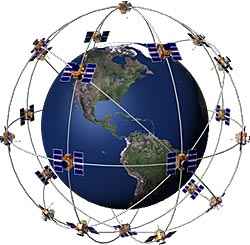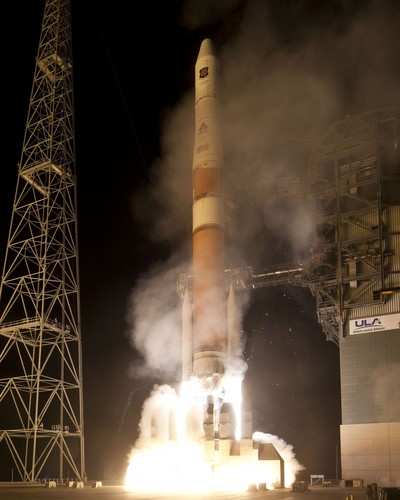Mon, May 31, 2010
GPS IIF-1 Satellite Sends 1st Signals from Space
 The first on-orbit signals from the new GPS IIF-1 satellite,
the inaugural spacecraft in a 12-satellite constellation that the
company is building for the U.S. Air Force have been received. The
signals indicate that the spacecraft bus is functioning normally
and ready to begin orbital maneuvers and operational testing.
The first on-orbit signals from the new GPS IIF-1 satellite,
the inaugural spacecraft in a 12-satellite constellation that the
company is building for the U.S. Air Force have been received. The
signals indicate that the spacecraft bus is functioning normally
and ready to begin orbital maneuvers and operational testing.
A United Launch Alliance Delta IV rocket launched the GPS IIF-1
satellite at 11 p.m. Eastern time on May 27 from Cape Canaveral Air
Force Station. At 2:33 a.m., the satellite separated from the
rocket's upper stage, and a ground station on Diego Garcia in the
Indian Ocean received the first signals from the newest member of
the Air Force's GPS satellite constellation. The Air Force 19th
Space Operations Squadron and Boeing's Mission Operations Support
Center in El Segundo, Calif., confirmed that the satellite is
healthy. GPS signals from the spacecraft payload will be turned on
for test purposes in the coming weeks.
GPS is the U.S. Department of Defense's largest satellite
constellation, with 30 spacecraft on orbit. The GPS IIF satellites
will provide more precise and powerful signals, a longer design
life, and many other benefits to nearly 1 billion civilian and
military users worldwide.
"The inaugural launch of the GPS IIF-1 is a milestone in
Boeing's 30 years of support to the Air Force that goes back to the
first days of this program," said Craig Cooning, vice president and
general manager, Boeing Space and Intelligence Systems. "The new
GPS IIF satellites bring key improvements, including a more
jam-resistant military signal, a new civil signal to enhance
commercial aviation and search-and-rescue operations, and
significantly improved signal accuracy as more of these new
satellites go into operation."
The GPS IIF-1 satellite will undergo months of on-orbit tests,
including functional testing of its payloads and end-to-end system
testing to verify operability with older GPS satellites, ground
receivers, and the ground control system.

Boeing has production of the next 11 GPS IIF satellites well
under way as it implements an innovative pulse-line manufacturing
approach that will help deliver the satellite fleet on schedule.
Adapted from Boeing aircraft and helicopter assembly lines, the
Boeing GPS IIF pulse line efficiently moves satellites under
development from one work area to the next in a steady, pulse-like
rhythm. The second GPS IIF satellite is scheduled for launch later
this year.
More News
“Setting eight speed records this quickly following its August entry into service is a powerful testament to the tremendous capabilities of this aircraft. We are already seei>[...]
On-Course Indication An indication on an instrument, which provides the pilot a visual means of determining that the aircraft is located on the centerline of a given navigational t>[...]
Aero Linx: WW1 Aeroplanes, Inc. WORLD WAR 1 AEROPLANES was founded by Leo Opdycke in 1961 and incorporated as a federally recognized 501 (c) (3) not-for-profit corporation in 1979,>[...]
Pilot Reported That He Purchased The Airplane Earlier That Day Analysis: The pilot reported that he purchased the airplane earlier that day and completed a condition inspection tha>[...]
Also: Abu Dhabi’s 1st Vertiport Network, Anduril-EDGE Partner, Vertical Permit/eVTOL Regs Sierra Space’s Dream Chaser spaceplane has cleared another round of pre-flight>[...]
 Aero-News: Quote of the Day (11.18.25)
Aero-News: Quote of the Day (11.18.25) ANN's Daily Aero-Term (11.18.25): On-Course Indication
ANN's Daily Aero-Term (11.18.25): On-Course Indication ANN's Daily Aero-Linx (11.18.25)
ANN's Daily Aero-Linx (11.18.25) NTSB Final Report: Shoemaker Ronald R Pazmany PL-2
NTSB Final Report: Shoemaker Ronald R Pazmany PL-2 Airborne-NextGen 11.18.25: Dream Chaser Preps, Joby eTurbine, UAE Flt Test
Airborne-NextGen 11.18.25: Dream Chaser Preps, Joby eTurbine, UAE Flt Test




